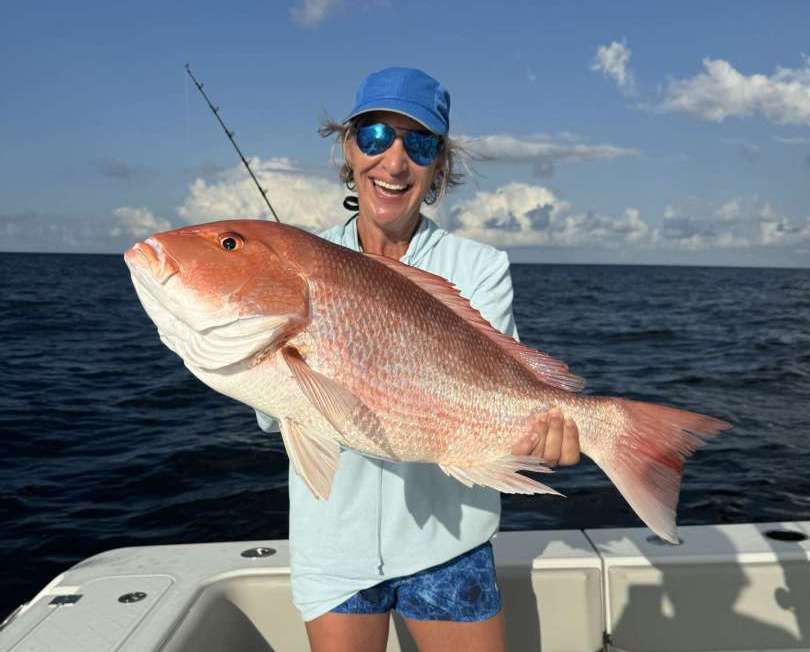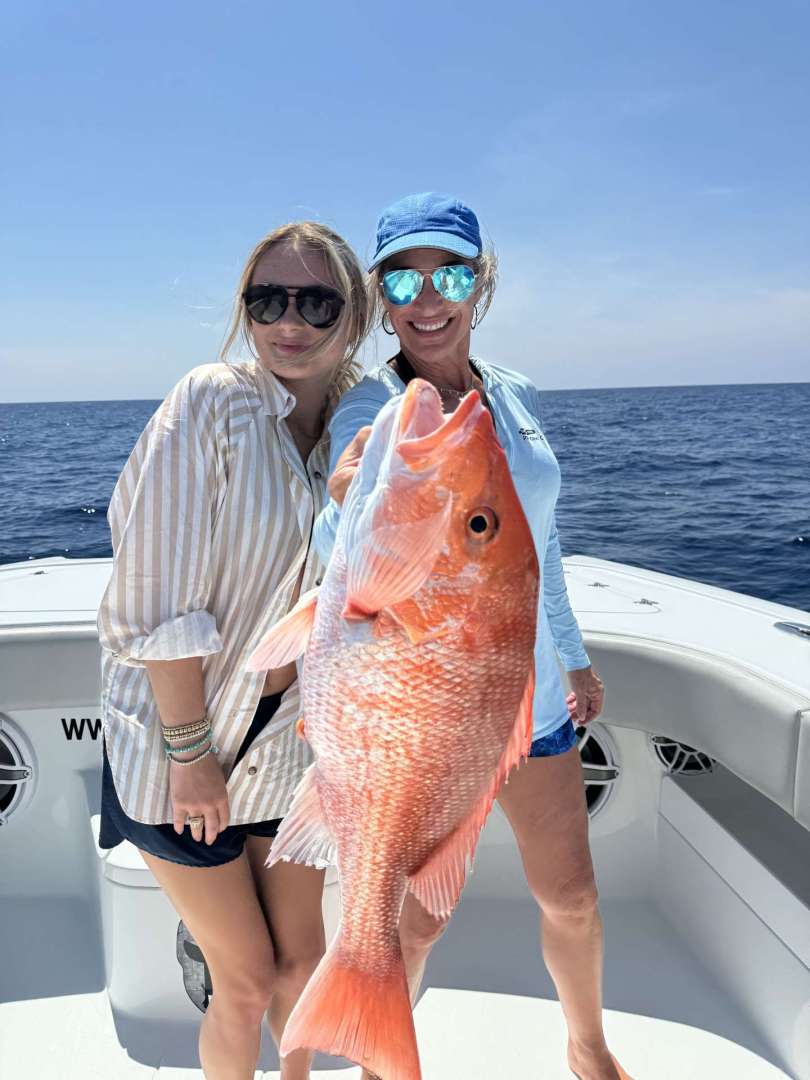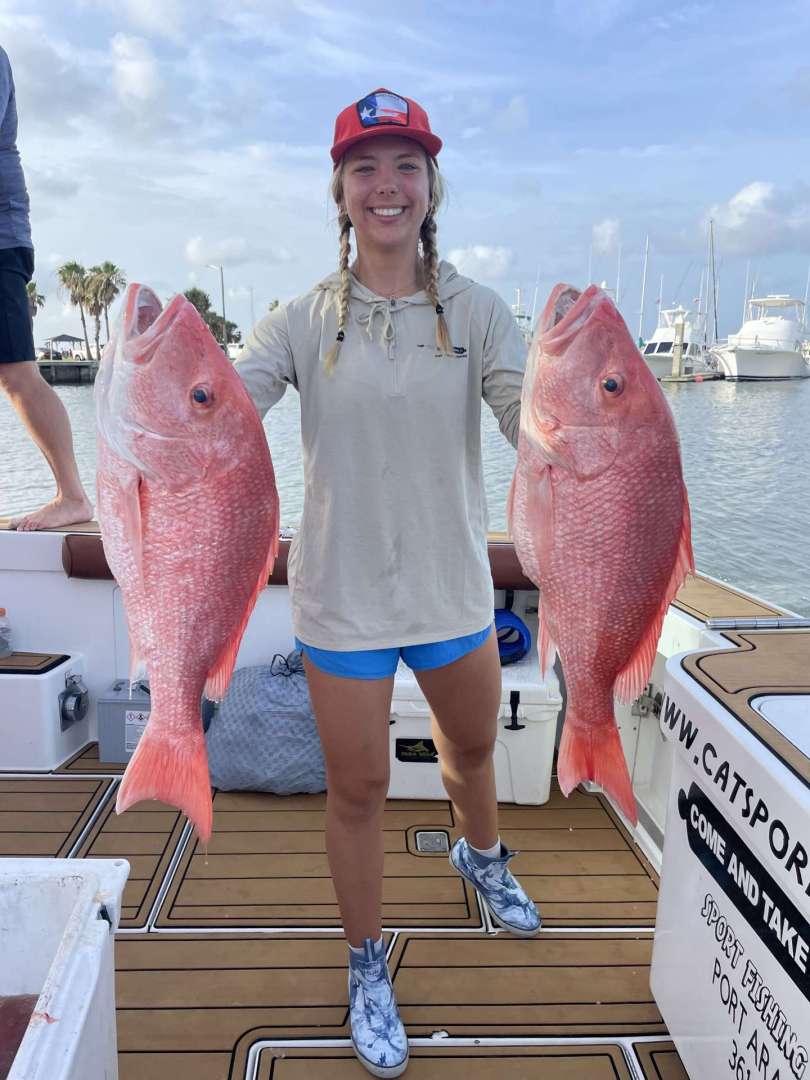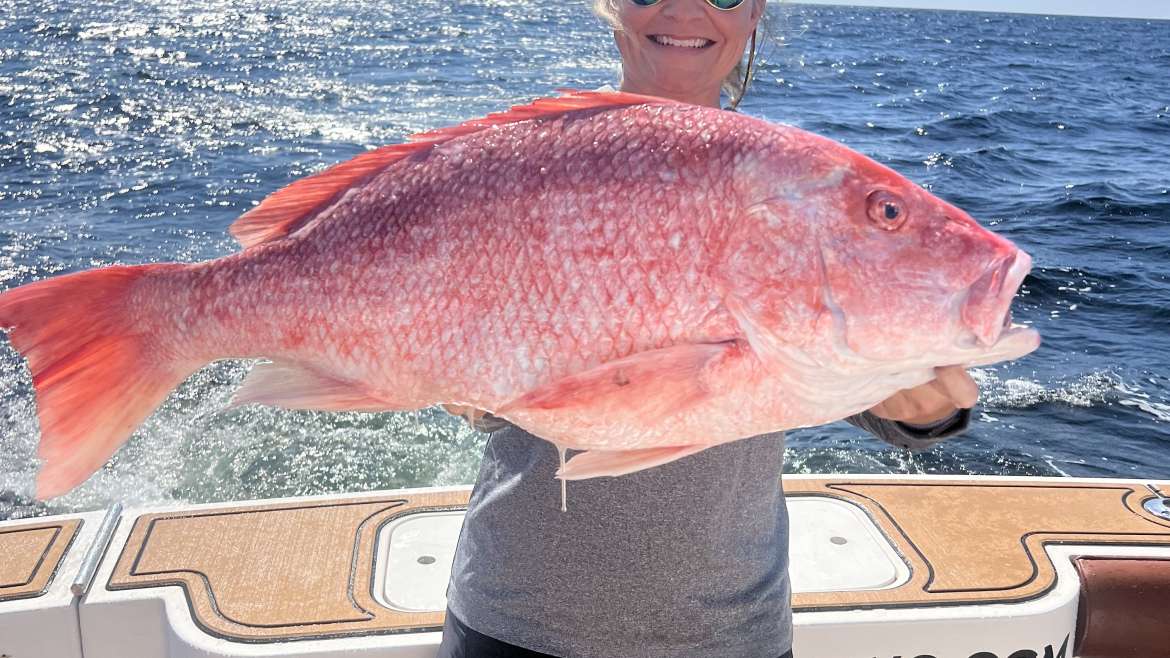Port Aransas red snapper fishing is one of the most popular offshore adventures. Anglers travel from across the country to experience catching this hard-fighting and great-tasting fish, making it a highlight of Gulf Coast fishing. Known for both its challenge and reward, red snapper has become a favorite target for beginners and seasoned fishermen alike.
In this guide, we will cover everything you need to know before planning a trip. You will learn about red snapper habits and habitat, the regulations that shape the season, the best times and locations to fish, and the techniques and gear that increase success. We will also explain what to expect on a guided trip with Come and Take It Sportfishing and highlight the role of conservation in protecting this species for the future.
What Makes Red Snapper Unique?
Species Overview
Red snapper are one of the most recognizable fish in the Gulf of Mexico. They have a bright red body, a streamlined shape, and can grow to impressive sizes, with many caught off Port Aransas weighing 10 to 20 pounds and occasionally much larger. These fish typically live around reefs, wrecks, and offshore structures, often staying close to the ocean floor at depths ranging from 30 feet in nearshore waters to more than 200 feet offshore. Their preference for structure makes them a reliable target for anglers who know where to look.
Because of their long lifespan and slow growth compared to other fish, red snapper populations must be carefully managed. They can live more than 40 years, although most caught in recreational fisheries are younger. This combination of longevity and popularity is one reason why regulations are in place to protect the species and ensure future fishing opportunities.
Why Anglers Target Red Snapper
Red snapper are prized for two main reasons: their fight and their flavor. They are powerful fish that put up a steady battle when hooked, making them exciting to catch for anglers of all skill levels. The challenge of pulling a big red snapper off the reef or wreck where it lives is part of what makes the experience memorable.
Beyond the fight, red snapper are highly valued as table fare. Their mild, white, flaky meat is considered one of the best eating fish available in the Gulf. For many visitors to Port Aransas, bringing home fillets for the grill or a local restaurant to cook is just as rewarding as the catch itself.
Misconceptions About Red Snapper
It is common for anglers new to Gulf fishing to confuse red snapper with other snapper species. Vermilion snapper, sometimes called “beeliners,” and lane snapper are often caught in the same waters and can look similar at first glance. Red snapper, however, are larger, have a more pronounced red color, and lack the distinct yellow or striped markings that other species show.
Another misconception is that red snapper can only be found far offshore. While some of the largest fish are caught in federal waters, state waters close to Port Aransas also hold healthy populations. This makes snapper fishing accessible to both first-time offshore anglers and those looking for longer deep sea trips.

Why Is Port Aransas a Top Red Snapper Destination?
Rich Reef Structures and Gulf Geography
Port Aransas is located on Mustang Island, directly connected to the Gulf of Mexico. This location provides quick access to a network of natural and artificial reefs, oil rigs, and underwater structures that red snapper use as habitat. These environments create ideal conditions for both juvenile and mature fish, giving anglers consistent opportunities throughout the year. The close proximity of these structures to the marina means less travel time and more fishing time for charter guests.
Accessibility and Fishing Hub
The city of Port Aransas is built around fishing, which makes it highly accessible for visiting anglers. Multiple marinas, boat ramps, and bait shops are available, supporting both charter captains and private fishermen. Hotels, restaurants, and rental homes are located close to the docks, making it easy for families and groups to plan trips without logistical challenges. This infrastructure allows anglers to focus on fishing instead of worrying about travel or preparation.
Experienced Guides and Tradition
Offshore fishing has been part of Port Aransas culture for generations, and the area is home to many skilled captains who know the local waters well. This tradition of offshore fishing means anglers benefit from a depth of knowledge passed down over time. Guides understand how to adapt to changing conditions, select the best reefs, and adjust techniques for the season. For visitors, fishing with an experienced crew ensures both a safe trip and a high chance of success.
Combining Fishing with Local Attractions
A red snapper trip is only part of what Port Aransas offers. The community features local seafood restaurants that will cook your catch, beach access for relaxation, and family-friendly attractions for downtime. Many anglers combine fishing trips with vacations, making Port Aransas a destination where both anglers and non-anglers can enjoy themselves. This blend of world-class fishing and coastal recreation is a major reason the city continues to attract red snapper enthusiasts year after year.
When Is the Best Time to Catch Red Snapper in Port Aransas?
Prime Months and Seasons
The peak season for red snapper in Port Aransas depends on whether you are fishing in state or federal waters. State waters are open year-round, which means anglers have opportunities every month of the year. Federal waters, however, have a much shorter season that usually opens in June and can last several weeks depending on harvest levels. Many anglers plan trips around the federal season because larger fish are often caught farther offshore, but state waters can still provide excellent action, especially in spring and fall.
How Water Temperature and Weather Affect Activity
Red snapper are most active when water temperatures are warm and stable. In Port Aransas, this usually occurs from late spring through early fall. Calm weather patterns during the summer create the safest and most productive conditions for offshore fishing. Cold fronts in winter can slow activity, but fish remain present around reefs and structures year-round. Paying attention to weather forecasts and sea conditions is just as important as tracking the calendar.
Daily Conditions to Watch
Success on the water often comes down to timing. Red snapper are bottom-dwelling fish, but they feed more aggressively during certain parts of the day. Early morning and late afternoon are generally considered prime feeding times. Other conditions that can influence success include:
- Tidal movement, which stirs up baitfish and creates feeding opportunities
- Moon phases, with stronger activity often observed around new and full moons
- Current strength, which can affect how fish hold near reefs and wrecks
By planning around both seasonal and daily conditions, anglers greatly improve their chances of success. Charter captains in Port Aransas monitor all of these factors and use their experience to pick the best times to head offshore, giving guests the best possible opportunity to land a quality red snapper.

Where to Fish for Red Snapper
Nearshore vs Offshore Differences
Port Aransas fishing spots offer access to both nearshore and offshore red snapper fishing. Nearshore spots within state waters are often closer to artificial reefs, jetties, and man-made structures. These areas are ideal for shorter trips and are a great option for beginners or families who want to stay closer to shore. Offshore locations in federal waters, on the other hand, are much farther out and require longer boat rides. The reward is often bigger fish and less fishing pressure. For many anglers, offshore trips are worth the extra time because of the opportunity to target trophy-sized snapper.
Travel Time and Distances
Fishing in state waters generally requires less than an hour of travel from Port Aransas marinas. In contrast, federal waters often mean rides of 20 to 40 miles offshore, which can take several hours depending on sea conditions. A half-day trip is often enough to reach state water snapper grounds, while a full-day trip is better suited for offshore runs into federal waters. Choosing the right option depends on how much time you want to spend on the water and the size of fish you hope to catch.
Why Local Knowledge Matters
Knowing where to go is half the battle in red snapper fishing. While maps may show reef locations, it takes local experience to know which spots are producing at any given time. Factors such as current, water clarity, and recent fishing pressure all affect success. Charter captains in Port Aransas use advanced sonar equipment to locate schools of snapper, but they also rely on years of experience to make quick decisions about when to stay put and when to move. For guests, this knowledge means less time searching and more time catching.
Best Gear, Bait & Techniques
Tackle Setup
Catching red snapper requires gear that can handle both the power of the fish and the depth at which they live. A medium to heavy conventional rod paired with a strong reel is the standard choice. Braided line in the 50 to 80 pound range provides strength without too much stretch, which is important when pulling fish away from reef structures. Anglers often use fluorocarbon leaders to reduce visibility and withstand sharp teeth. Weights vary depending on the current and depth, but rigs should be heavy enough to keep bait near the bottom where snapper feed.
Bait Choices
Red snapper respond well to a variety of baits, but some are more effective than others. Live bait such as cigar minnows, pinfish, and sardines are excellent for enticing larger fish. Dead bait, including squid and cut pieces of bonito or mullet, is reliable and widely used. Artificial lures can also be effective, with vertical jigs and soft plastics mimicking the movement of prey fish. The key is to use bait that matches the local forage and to keep presentations natural.
Fishing Strategies
Most red snapper are caught using bottom fishing techniques. This involves dropping baited rigs directly over structure and holding near the seafloor. Anchoring in the right spot is important to stay positioned over reefs and wrecks. Drifting can also work in areas where current allows, giving anglers a chance to cover more ground. Vertical jigging has become increasingly popular, as it adds motion that can trigger aggressive strikes from larger fish. Regardless of the method, patience and consistent checks on bait are necessary to maximize success.
Tips from the Pros
Experienced anglers and charter crews often share small adjustments that improve results. These include:
- Keeping hooks sharp to ensure solid hooksets
- Changing bait frequently to maintain freshness
- Watching sonar for schools holding just above the structure
- Being ready to reel quickly once a fish bites to keep it from diving into cover
By combining the right tackle, effective bait, and proven techniques, anglers in Port Aransas can increase their chances of landing quality red snapper on every trip.
What to Expect on a Charter with Come and Take It Sportfishing
Trip Types
Come and Take It Sportfishing offers different trip lengths to match the goals of each group. Half-day trips are often spent in state waters where red snapper are accessible with less travel time. Full-day trips head farther offshore into federal waters, giving anglers the chance to target larger types of fish in Port Aransas and enjoy a longer fishing experience. Both options are designed to maximize time on the water while matching the comfort level of the group.
What’s Included
Most of the essentials are provided to make the day stress-free. High-quality rods, reels, and tackle are supplied, along with bait chosen for the conditions. The crew also handles licensing and federal permits, which simplifies the process for guests. At the end of the trip, fish cleaning services are often included so anglers can take home ready-to-cook fillets.
What to Bring
Guests should come prepared with a few personal items to stay comfortable during the day. Recommended items include:
- Food and drinks for the duration of the trip
- Sunscreen, hats, and sunglasses for sun protection
- A small cooler for taking fillets home
- Motion sickness prevention if needed
Packing these basics ensures that you can focus on fishing instead of worrying about what you forgot.
Safety and Comfort
The crew places a strong emphasis on safety. Boats are equipped with modern navigation equipment, life jackets, and communication devices. Captains monitor sea conditions carefully and make adjustments as needed to keep the trip safe. Comfort is also a priority, with shaded areas and seating available for downtime during travel between fishing spots.
Realistic Expectations
Red snapper trips are productive, but the experience is about more than just filling a cooler. Travel time, weather, and fish behavior can all affect the pace of the day. Guests should expect periods of fast action as well as times of patience while the crew locates the best structure. By setting realistic expectations and trusting the captain’s local knowledge, anglers enjoy a rewarding trip whether they land a limit or simply experience offshore fishing.
Sustainability and Conservation Practices
Proper Fish Handling and Release
Red snapper populations depend on anglers practicing responsible handling. When fish are released, using a venting tool or descending device is required to reduce the effects of barotrauma, which occurs when fish are brought up quickly from deep water. These tools help fish return to their natural depth safely and increase survival rates. Handling fish gently, avoiding prolonged time out of the water, and releasing them correctly are simple but important steps every angler can follow.
Why Bag and Size Limits Exist
Bag and size limits are not arbitrary rules. They are carefully designed to protect younger fish and ensure that enough mature snapper remain in the population to reproduce. Keeping fish above the minimum size helps maintain long-term stability of the fishery. These limits also create fair opportunities for both recreational and commercial anglers by preventing overharvest. Following them is essential for preserving red snapper for future generations.
Long-Term Management
The management of red snapper in the Gulf of Mexico is shared between state and federal agencies. Texas Parks and Wildlife Department oversees state waters, while federal waters are managed under national guidelines. Stock assessments, data collection, and quota monitoring all play a role in setting seasons and limits each year. These efforts have helped rebuild red snapper populations that were once heavily overfished. While regulations can be strict, they have proven successful in creating sustainable fishing opportunities.
How Come and Take It Sportfishing Supports Conservation
Charter operators are on the front line of conservation. Come and Take It Sportfishing follows all regulations closely and uses the required gear to release fish safely when needed. The crew also educates guests on why conservation matters and how to handle their catch responsibly. By teaching proper practices and demonstrating respect for the resource, the charter helps ensure that red snapper fishing remains strong in Port Aransas for years to come.

Red Snapper Fishing Regulations in Port Aransas
State vs Federal Waters
When fishing for red snapper, understanding the difference between state and federal waters is essential. In Texas, state waters extend out to nine nautical miles from the shoreline, while federal waters begin beyond that point and continue into the Gulf. These boundaries matter because regulations often differ between the two zones. Port Aransas anglers can access both depending on the type of trip they book, but each area has its own rules for season dates and limits.
Licensing and Permit Requirements
Every angler fishing in Texas must have a valid fishing license along with a saltwater endorsement. Out-of-state visitors can purchase temporary licenses for the duration of their trip. On most guided charters, the crew ensures that all requirements are met, but it is still a good idea to confirm what is included in the trip package. Federal permits are handled by licensed captains, which allows guests to focus on fishing without worrying about paperwork.
Enforcement and Penalties
Regulations are closely monitored by agencies such as the Texas Parks and Wildlife Department and the U.S. Coast Guard. Random checks on the water are common, and exceeding bag or size limits can result in heavy fines or loss of fishing privileges. Following the rules not only keeps you compliant but also supports the long-term health of red snapper populations in the Gulf of Mexico.
Tips to Maximize Your Catch
Plan Ahead
Success on a red snapper trip often starts before the boat leaves the dock. Checking the Port Aransas fishing report, reviewing weather forecasts, and understanding tidal conditions help set the stage for a productive day. Booking early during federal season is important since availability can fill quickly. Preparing gear, food, and personal items ahead of time ensures you spend more time fishing and less time worrying about details.
Listen to Your Captain and Crew
Charter crews have years of local knowledge that make the difference between an average day and a great one. Captains know where the fish are holding and how conditions are changing throughout the trip. Following their instructions on when to drop lines, how to set the hook, and how to reel in quickly can dramatically improve your chances of landing keeper-sized fish.
Keep Your Gear Ready
Small details with your gear can have a big impact. Hooks should be sharp, leaders should be checked for fraying, and weights should match the current and depth. Changing out bait often keeps your presentation fresh and appealing. Being ready to drop lines as soon as the boat is positioned over a productive reef helps you take advantage of active feeding windows.
Stay Patient and Adaptable
Red snapper fishing is not always non-stop action. There may be periods of waiting while the captain searches for active schools or while currents shift. Staying patient and ready to adjust tactics is part of the process. Switching from dead bait to live bait, moving slightly to a different depth, or changing rigs can sometimes turn a slow day into a successful one.
By combining preparation, attentiveness, and flexibility, anglers put themselves in the best position to enjoy both the fight and the reward of red snapper fishing in Port Aransas.
FAQs About Port Aransas Red Snapper Fishing
What is the best time of year to catch red snapper in Port Aransas?
The best time to catch red snapper depends on whether you are fishing in state or federal waters. State waters are open year-round, while federal waters typically open in June and run for several weeks during the summer. Most anglers target the federal season since it often produces larger fish, but state waters can still provide consistent action.
How far offshore do you have to go to catch red snapper in Port Aransas?
Red snapper can be caught both nearshore and offshore. In state waters, anglers may find them as close as 5 to 9 miles offshore around reefs and structures. In federal waters, trips often run 20 to 40 miles offshore where the fish are generally bigger.
What is the size and bag limit for red snapper in Port Aransas?
In state waters, anglers can typically keep four red snapper per person per day with a minimum length of 15 inches. In federal waters, the limit is usually two fish per person with a minimum length of 16 inches. These rules are subject to change, so checking the latest regulations before your trip is important.
Do I need a fishing license to catch red snapper in Port Aransas?
Yes, all anglers in Texas need a valid fishing license with a saltwater endorsement. Out-of-state visitors can purchase short-term licenses that cover the duration of their trip. Most charters, including Come and Take It Sportfishing, handle federal permits, but guests are responsible for individual licenses unless stated otherwise.
Can beginners catch red snapper in Port Aransas?
Yes, red snapper are a great target species for beginners. They bite consistently, fight hard, and can be caught with simple rigs and bait. Booking a deep sea fishing Port Aransas charter, makes the experience even easier since the crew provides all the gear and instruction needed.
What happens if the weather cancels a red snapper trip in Port Aransas?
Safety is always the top priority, and captains will not head offshore in unsafe conditions. If weather cancels a trip, most charters will reschedule for another day or provide options for refunds depending on availability. Planning flexibility into your trip helps ensure you still get the chance to fish.
Port Aransas Red Snapper Fishing: Plan Your Trip Today
Red snapper fishing in Port Aransas is one of the most rewarding experiences on the Texas Gulf Coast. With healthy populations, clear regulations, and prime fishing grounds, anglers of all experience levels have the chance to land this prized species. In this guide, we covered what makes red snapper unique, the rules that govern the season, the best times and places to fish, proven gear and techniques, and the value of fishing with an experienced charter. Sustainability and proper handling also play a key role in keeping this fishery strong for years to come.
If you are ready to experience catching red snapper, now is the time to plan your trip. Book with Come and Take It Sportfishing and enjoy expert guidance, top-quality gear, and a crew dedicated to making your Port Aransas fishing adventure unforgettable.


